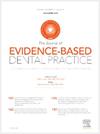ARTIFICIAL INTELLIGENCE PLATFORMS IN DENTAL CARIES DETECTION: A SYSTEMATIC REVIEW AND META-ANALYSIS
IF 4
4区 医学
Q1 DENTISTRY, ORAL SURGERY & MEDICINE
引用次数: 0
Abstract
Objectives
To assess Artificial Intelligence (AI) platforms, machine learning methodologies and associated accuracies used in detecting dental caries from clinical images and dental radiographs.
Methods
A systematic search of 8 distinct electronic databases: Scopus, Web of Science, MEDLINE, Educational Resources Information Centre, Institute of Electrical and Electronics Engineers Explore, Science Direct, Directory of Open Access Journals and JSTOR, was conducted from January 2000 to March 2024. AI platforms, machine learning methodologies and associated accuracies of studies using AI for dental caries detection were extracted along with essential study characteristics. The quality of included studies was assessed using QUADAS-2 and the CLAIM checklist. Meta-analysis was performed to obtain a quantitative estimate of AI accuracy.
Results
Of the 2538 studies identified, 45 met the inclusion criteria and underwent qualitative synthesis. Of the 45 included studies, 33 used dental radiographs, and 12 used clinical images as datasets. A total of 21 different AI platforms were reported. The accuracy ranged from 41.5% to 98.6% across reported AI platforms. A quantitative meta-analysis across 7 studies reported a mean sensitivity of 76% [95% CI (65% - 85%)] and specificity of 91% [(95% CI (86% - 95%)]. The area under the curve (AUC) was 92% [95% CI (89% - 94%)], with high heterogeneity across included studies.
Conclusion
Significant variability exists in AI performance for detecting dental caries across different AI platforms. Meta-analysis demonstrates that AI has superior sensitivity and equal specificity of detecting dental caries from clinical images as compared to bitewing radiography. Although AI is promising for dental caries detection, further refinement is necessary to achieve consistent and reliable performance across varying imaging modalities.
人工智能平台在龋齿检测中的应用:系统综述和荟萃分析
目的评估人工智能(AI)平台、机器学习方法及其在从临床图像和牙科x光片检测龋齿中的准确性。方法从2000年1月至2024年3月对Scopus、Web of Science、MEDLINE、Educational Resources Information Centre、Institute of Electrical and Electronics Engineers Explore、Science Direct、Directory of Open Access Journals和JSTOR 8个不同的电子数据库进行系统检索。提取了人工智能平台、机器学习方法和使用人工智能进行龋齿检测的相关准确性,以及基本的研究特征。采用QUADAS-2和CLAIM清单评估纳入研究的质量。进行荟萃分析以获得人工智能准确性的定量估计。结果在2538项研究中,45项符合纳入标准,并进行了定性综合。在纳入的45项研究中,33项使用牙科x光片,12项使用临床图像作为数据集。总共报告了21个不同的人工智能平台。在报告的人工智能平台上,准确率从41.5%到98.6%不等。7项研究的定量荟萃分析报告,平均敏感性为76% [95% CI(65% - 85%)],特异性为91% [95% CI(86% - 95%)]。曲线下面积(AUC)为92% [95% CI(89% - 94%)],在纳入的研究中具有高度异质性。结论不同平台的人工智能检测龋病的性能存在显著差异。荟萃分析表明,人工智能在临床图像中检测龋齿的灵敏度和特异性优于咬翼x线摄影。虽然人工智能在龋齿检测方面很有前景,但需要进一步改进,才能在不同的成像模式下实现一致和可靠的性能。
本文章由计算机程序翻译,如有差异,请以英文原文为准。
求助全文
约1分钟内获得全文
求助全文
来源期刊

Journal of Evidence-Based Dental Practice
DENTISTRY, ORAL SURGERY & MEDICINE-
CiteScore
6.00
自引率
16.70%
发文量
105
审稿时长
28 days
期刊介绍:
The Journal of Evidence-Based Dental Practice presents timely original articles, as well as reviews of articles on the results and outcomes of clinical procedures and treatment. The Journal advocates the use or rejection of a procedure based on solid, clinical evidence found in literature. The Journal''s dynamic operating principles are explicitness in process and objectives, publication of the highest-quality reviews and original articles, and an emphasis on objectivity.
 求助内容:
求助内容: 应助结果提醒方式:
应助结果提醒方式:


